sensor TOYOTA YARIS HATCHBACK 2020 (in English) Owner's Guide
[x] Cancel search | Manufacturer: TOYOTA, Model Year: 2020, Model line: YARIS HATCHBACK, Model: TOYOTA YARIS HATCHBACK 2020Pages: 572, PDF Size: 7.94 MB
Page 229 of 572

YARIS_YARIS HATCHBACK_OM_OM99V59z_(U)
2293-10. Active Safety System
3
When Driving
●The Low Speed Pre-Collision System will not operate if the driv er is deliber-
ately performing driving operations (accelerator pedal and stee ring wheel).
● The Low Speed Pre-Collision System will operate under the follo wing condi-
tions.
• The engine is running.
• The Low Speed Pre-Collision System warning light (amber) does not illu-
minate.
• The vehicle speed is between about 2 to 18 mph (4 to 30 km/h).
• The Low Speed Pre-Collision System is not turned off.
• The DSC is not malfunctioning.
● The Low Speed Pre-Collision System detects a vehicle ahead by emitting a
near-infrared laser beam and receiving the beam reflected off the reflector
of the vehicle ahead, and then using it for the measurement. Co nsequently,
the Low Speed Pre-Collision System may not operate under the following
conditions:
• Reflection of the laser is poor due to the shape of the vehicl e ahead.
• The vehicle ahead is significantly dirty.
• Under bad weather condition, such as rain, fog and snow.
• The window washer is being used or the windshield wipers are not used when it’s raining.
• The windshield is dirty.
• The steering wheel is turned completely left or right, or the vehicle is
accelerated rapidly and comes close to the vehicle ahead.
• Trucks with low loading platforms and vehicles with an extreme ly low or
high profile.
• Vehicles with certain shapes such as a vehicle carrier.
● Under the following conditions, the Low Speed Pre-Collision Sys tem may
not operate normally.
• Heavy luggage is loaded in the luggage compartment or on the r ear seat.
• If there is the possibility of partial contact with a vehicle ahead.
• When driving on continuously curving roads, and entering and e xiting
exits.
• Elongated luggage or cargo is loaded onto installed roof rails and covers
the laser sensor.
• Exhaust gas from the vehicle in front, sand, snow, and water v apor rising
from manholes and grating, and water splashed into the air.
• When towing a malfunctioning vehicle.
• When driving with tires having significantly different wear.
Page 230 of 572

230
YARIS_YARIS HATCHBACK_OM_OM99V59z_(U)
3-10. Active Safety System
●In the following cases, the laser sensor may inadvertently dete rmine that
there is a vehicle ahead and the Low Speed Pre-Collision System may oper-
ate.
• Objects on the road at the entrance to a curve.
• Vehicles passing in the opposite lane while making a curve.
• Metal objects, bumps, or protruding objects on the road.
• When passing through a toll gate equipped with a bar.
• When passing under a vinyl curtain or flag.
• Plastic objects such as pylons.
• Two-wheeled vehicles, pedestrians, animals or standing trees.
● Manual transaxle:
If the vehicle is stopped by the Low Speed Pre-Collision System operation
and the clutch pedal is not depressed, the engine stops.
● The Low Speed Pre-Collision System warning light (amber) turns on when
the system has a malfunction.
Refer to Warning Lights on P. 173.
Page 231 of 572

YARIS_YARIS HATCHBACK_OM_OM99V59z_(U)
2313-10. Active Safety System
3
When Driving
WARNING
■Do not rely on the Low Speed Pre -Collision System as a substitute for
safer driving
The Low Speed Pre-Collision System cannot compensate for unsafe and
reckless driving, excessive speed, tailgating (following anothe r vehicle too
closely), and driving on slippery roads such as wet, snowy, and icy roads
(reduced tire friction and road contact because of water on the road sur-
face). You can still have an accident.
■ Do not rely completely on the Low Speed Pre-Collision System
● The Low Speed Pre-Collision System is only designed to reduce d amage
in the event of a collision. Over reliance on the system leadin g to the
accelerator pedal or brake pedal being mistakenly operated coul d result in
an accident.
● The Low Speed Pre-Collision System is a system which operates in
response to a vehicle ahead. The system may not be able to detect or
react to two-wheeled vehicles or pedestrians.
● The laser sensor for the Low Speed Pre-Collision System is inst alled near
the rearview mirror. To assure the correct operation of the Low Speed Pre-
Collision System, heed the following cautions.
• Do not apply stickers to the surface of the windshield near the laser sensor (including transparent stickers). Otherwise, the laser s ensor
may not be able to detect vehicles ahead which could result in an acci-
dent.
• Do not apply coating agent to the windshield. Otherwise, the l aser sen-
sor may not be able to detect vehicles or obstructions in front which
could result in an accident.
• Do not disassemble the laser sensor.
• If cracks or damage caused by flying gravel or debris is visib le near
the laser sensor, stop using the Low Speed Pre-Collision System
immediately and have your vehicle inspected by your Toyota deal er. If
the vehicle continues to be driven with cracks or scratch marks left on
the windshield near the laser sensor, the system may operate un nec-
essarily and cause an unexpected accident.
Refer to Stopping The Low Speed Pre-Collision System Operation on
P. 2 3 3 .
• When replacing the windshield wi pers or windshield, consult your
Toyota dealer.
● The laser sensor includes a function for detecting a soiled windshield and
informing the driver, however, depending on the conditions, it may not
detect plastic shopping bags, ice or snow on the windshield. In such
cases, the system cannot accurately determine a vehicle ahead a nd may
not be able to operate normally. Always drive carefully and pay attention to
the road ahead.
Page 234 of 572
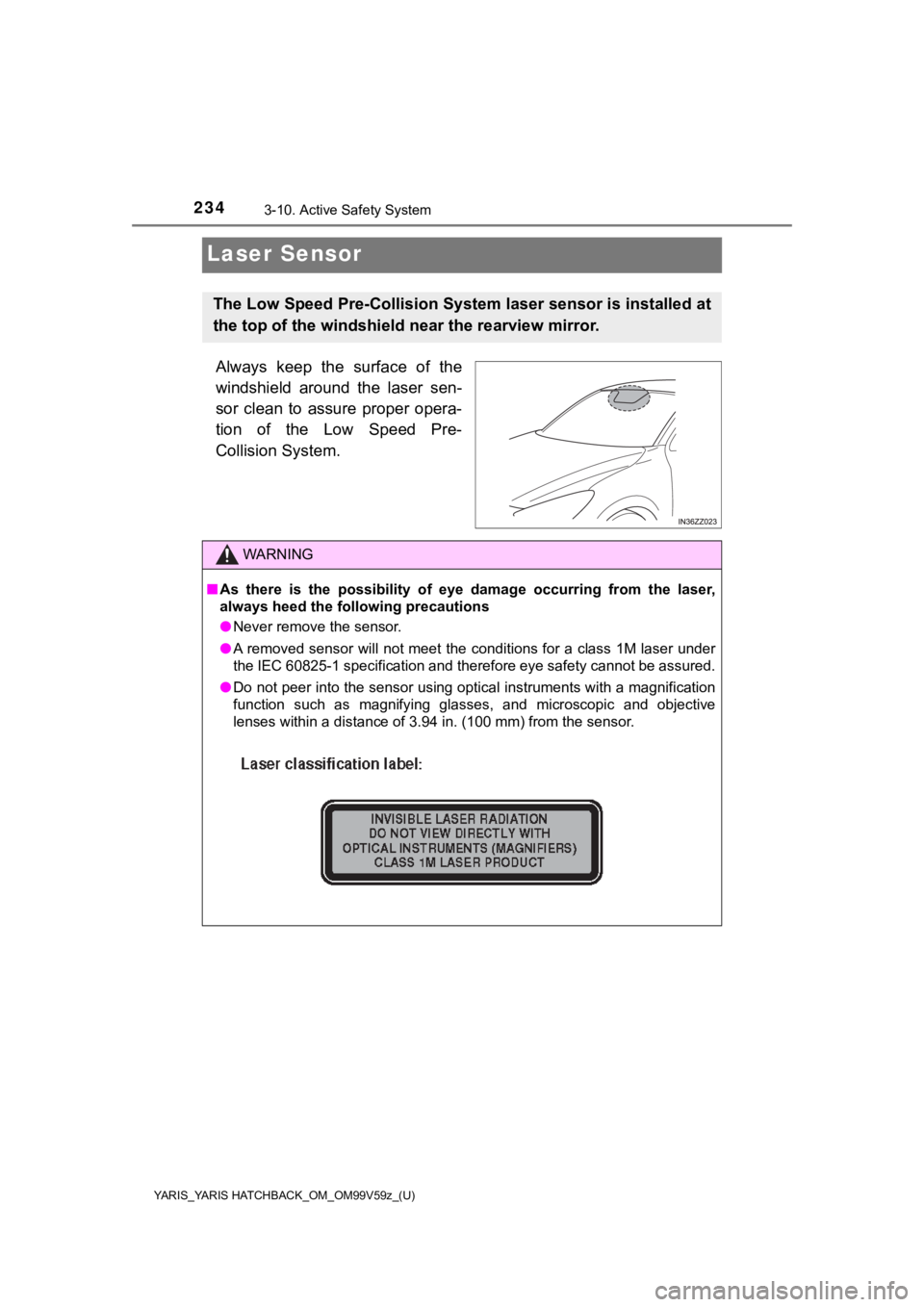
234
YARIS_YARIS HATCHBACK_OM_OM99V59z_(U)
3-10. Active Safety System
Laser Sensor
Always keep the surface of the
windshield around the laser sen-
sor clean to assure proper opera-
tion of the Low Speed Pre-
Collision System.
The Low Speed Pre-Collision System laser sensor is installed at
the top of the windshield near the rearview mirror.
WARNING
■As there is the possibility of eye damage occurring from the la ser,
always heed the following precautions
● Never remove the sensor.
● A removed sensor will not meet the conditions for a class 1M la ser under
the IEC 60825-1 specification and therefore eye safety cannot b e assured.
● Do not peer into the sensor using optical instruments with a ma gnification
function such as magnifying glasses, and microscopic and object ive
lenses within a distance of 3.94 in. (100 mm) from the sensor.
Page 235 of 572
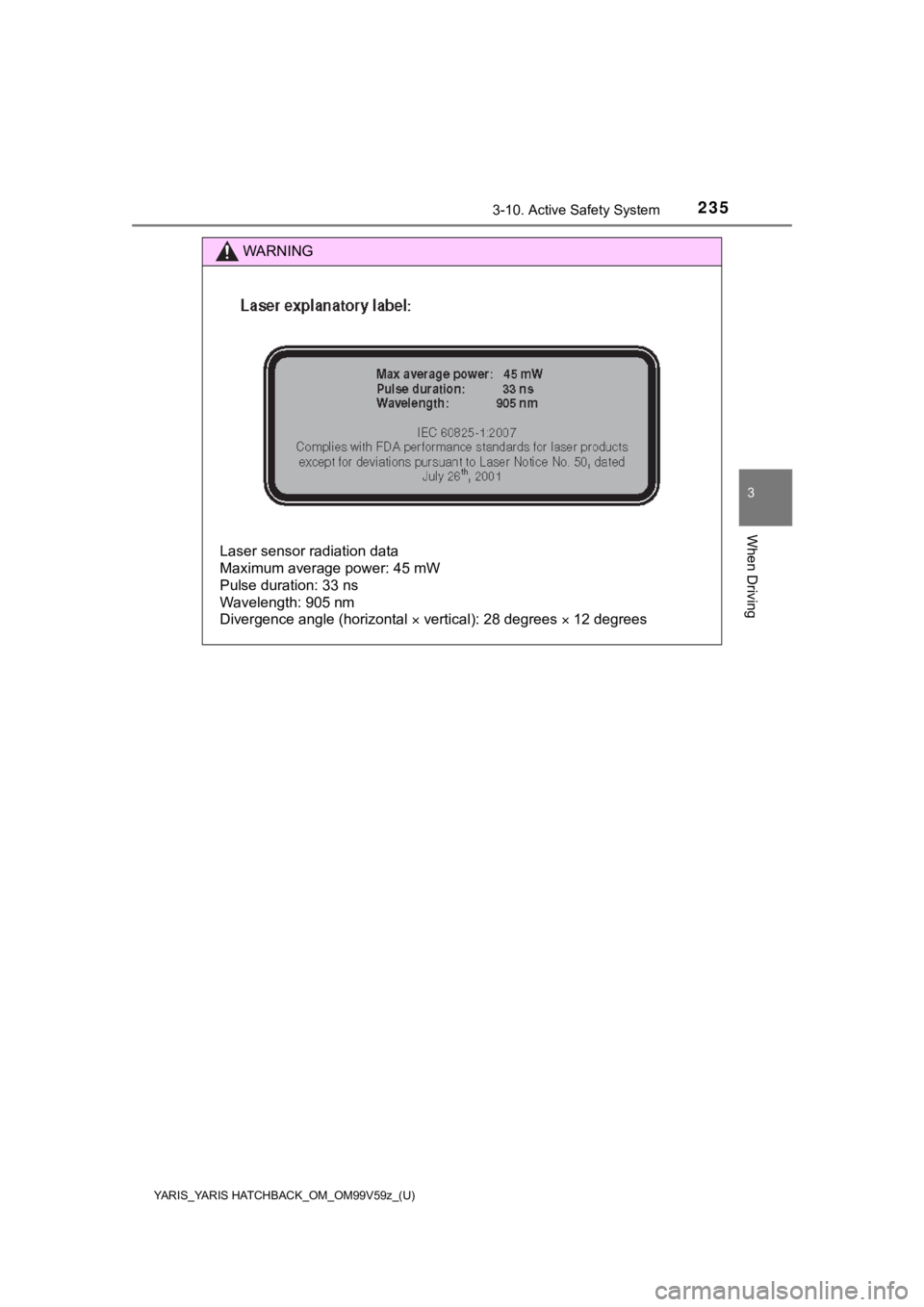
YARIS_YARIS HATCHBACK_OM_OM99V59z_(U)
2353-10. Active Safety System
3
When Driving
WARNING
Laser sensor radiation data
Maximum average power: 45 mW
Pulse duration: 33 ns
Wavelength: 905 nm
Divergence angle (horizontal vertical): 28 degrees 12 degrees
Page 241 of 572
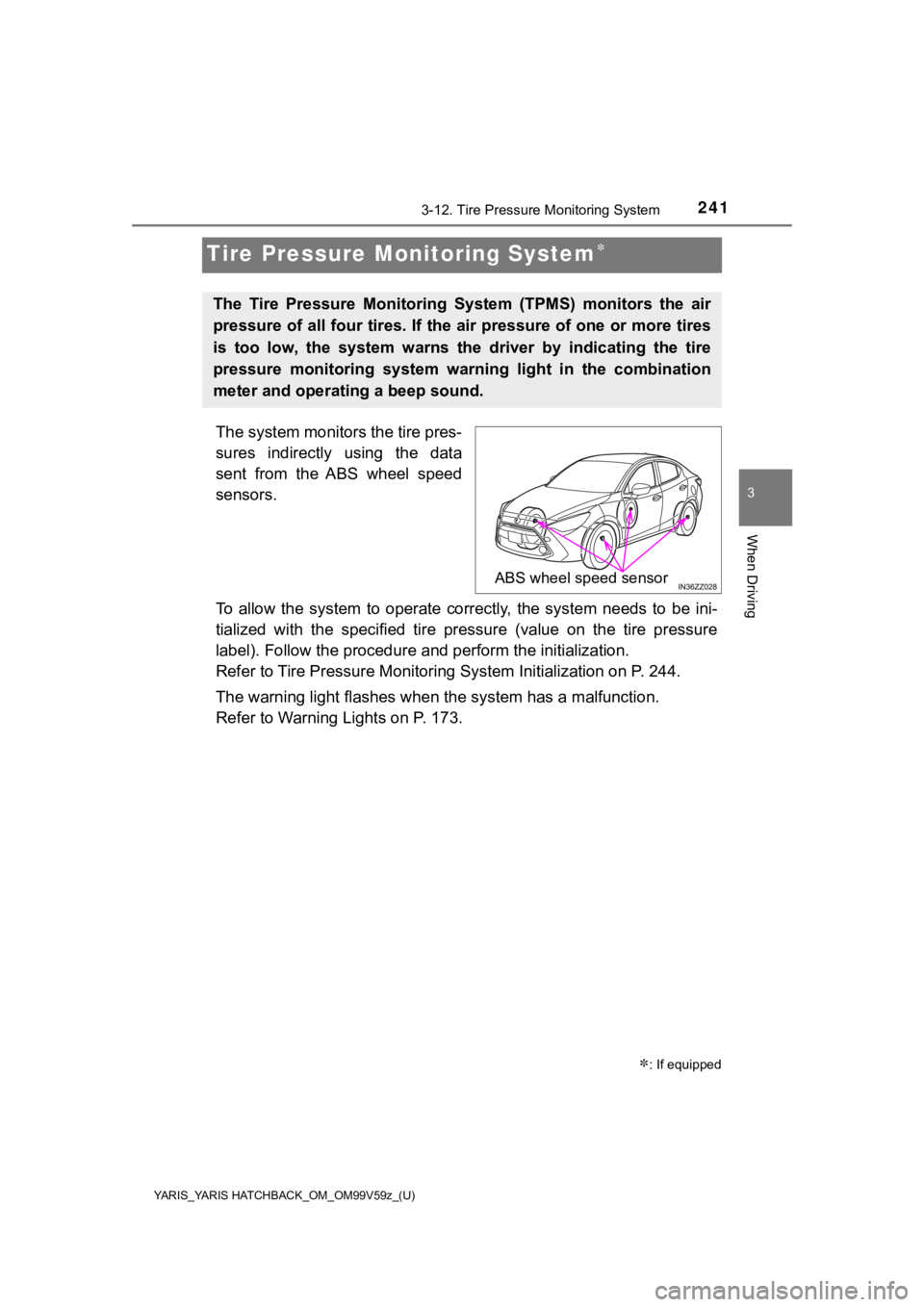
241
YARIS_YARIS HATCHBACK_OM_OM99V59z_(U)
3-12. Tire Pressure Monitoring System
3
When Driving
Tire Pressure Monitoring System
The system monitors the tire pres-
sures indirectly using the data
sent from the ABS wheel speed
sensors.
To allow the system to operate correctly, the system needs to b e ini-
tialized with the specified tire pressure (value on the tire pressure
label). Follow the procedure and perform the initialization.
Refer to Tire Pressure Monitorin g System Initialization on P. 244.
The warning light flashes when the system has a malfunction.
Refer to Warning Lights on P. 173.
: If equipped
The Tire Pressure Monitoring S ystem (TPMS) monitors the air
pressure of all four tires. If the air pressure of one or more tires
is too low, the system warns the driver by indicating the tire
pressure monitoring system warning light in the combination
meter and operating a beep sound.
ABS wheel sp eed sensor
Page 270 of 572
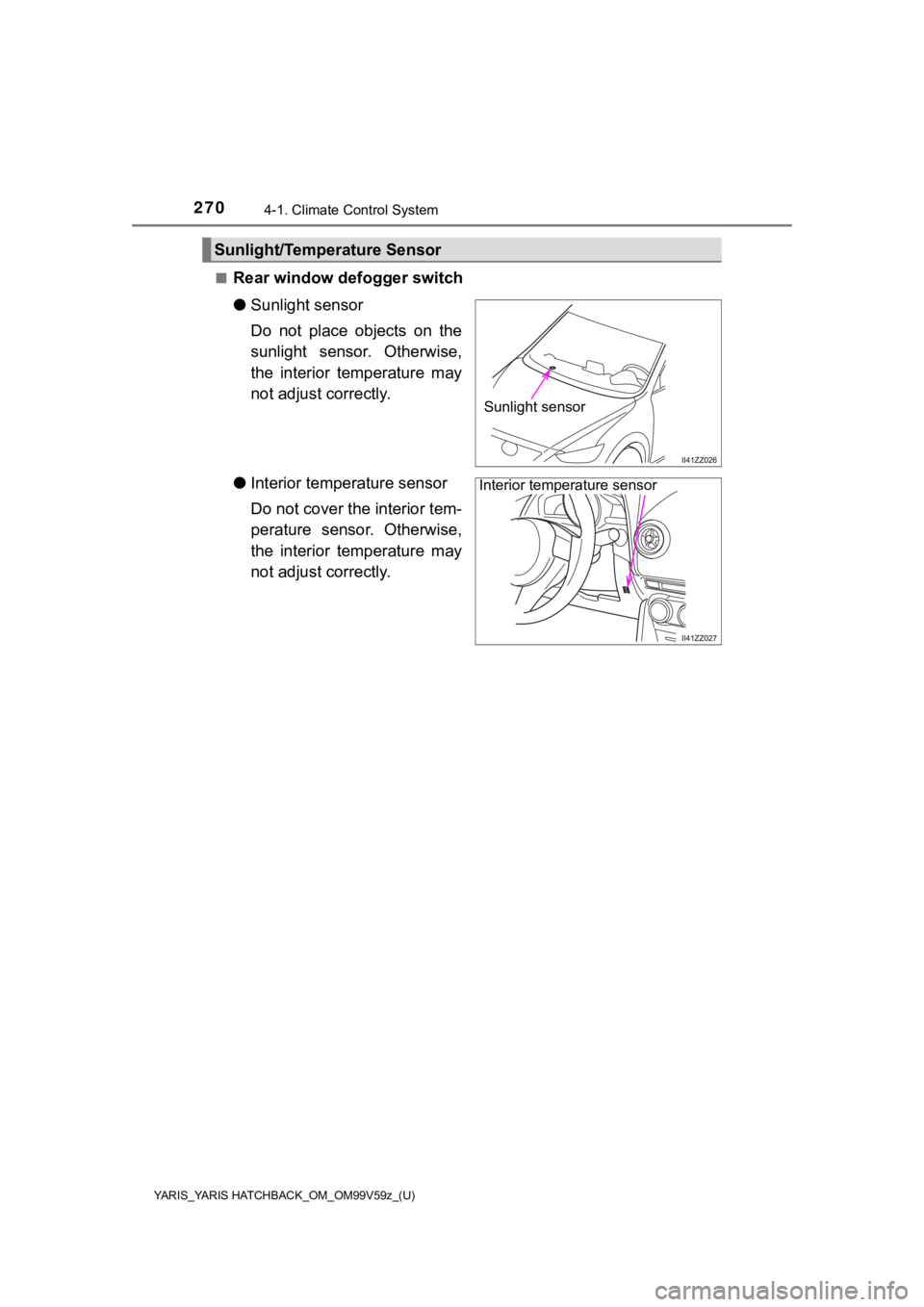
270
YARIS_YARIS HATCHBACK_OM_OM99V59z_(U)
4-1. Climate Control System
■Rear window defogger switch
●Sunlight sensor
Do not place objects on the
sunlight sensor. Otherwise,
the interior temperature may
not adjust correctly.
● Interior temperature sensor
Do not cover the interior tem-
perature sensor. Otherwise,
the interior temperature may
not adjust correctly.
Sunlight/Temperature Sensor
Sunlight sensor
Interior temperature sensor
Page 404 of 572
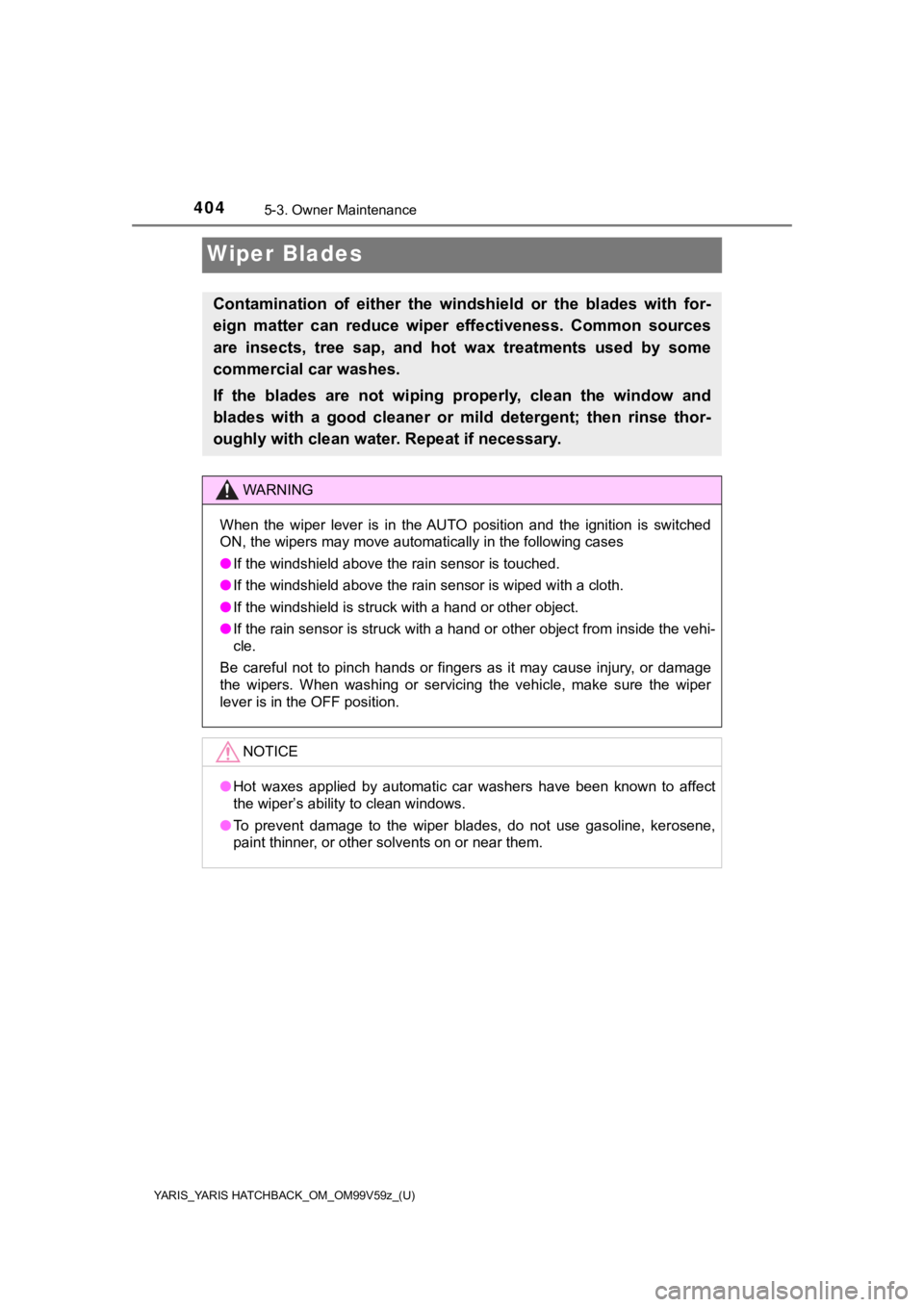
404
YARIS_YARIS HATCHBACK_OM_OM99V59z_(U)
5-3. Owner Maintenance
Wiper Blades
Contamination of either the windshield or the blades with for-
eign matter can reduce wiper effectiveness. Common sources
are insects, tree sap, and hot wax treatments used by some
commercial car washes.
If the blades are not wiping properly, clean the window and
blades with a good cleaner or mild detergent; then rinse thor-
oughly with clean water . Repeat if necessary.
WARNING
When the wiper lever is in the AUTO position and the ignition i s switched
ON, the wipers may move automatically in the following cases
● If the windshield above the rain sensor is touched.
● If the windshield above the rain sensor is wiped with a cloth.
● If the windshield is struck with a hand or other object.
● If the rain sensor is struck with a hand or other object from i nside the vehi-
cle.
Be careful not to pinch hands or fingers as it may cause injury , or damage
the wipers. When washing or servicing the vehicle, make sure the wiper
lever is in the OFF position.
NOTICE
● Hot waxes applied by automatic car washers have been known to a ffect
the wiper’s ability to clean windows.
● To prevent damage to the wiper blades, do not use gasoline, ker osene,
paint thinner, or other solvents on or near them.
Page 446 of 572
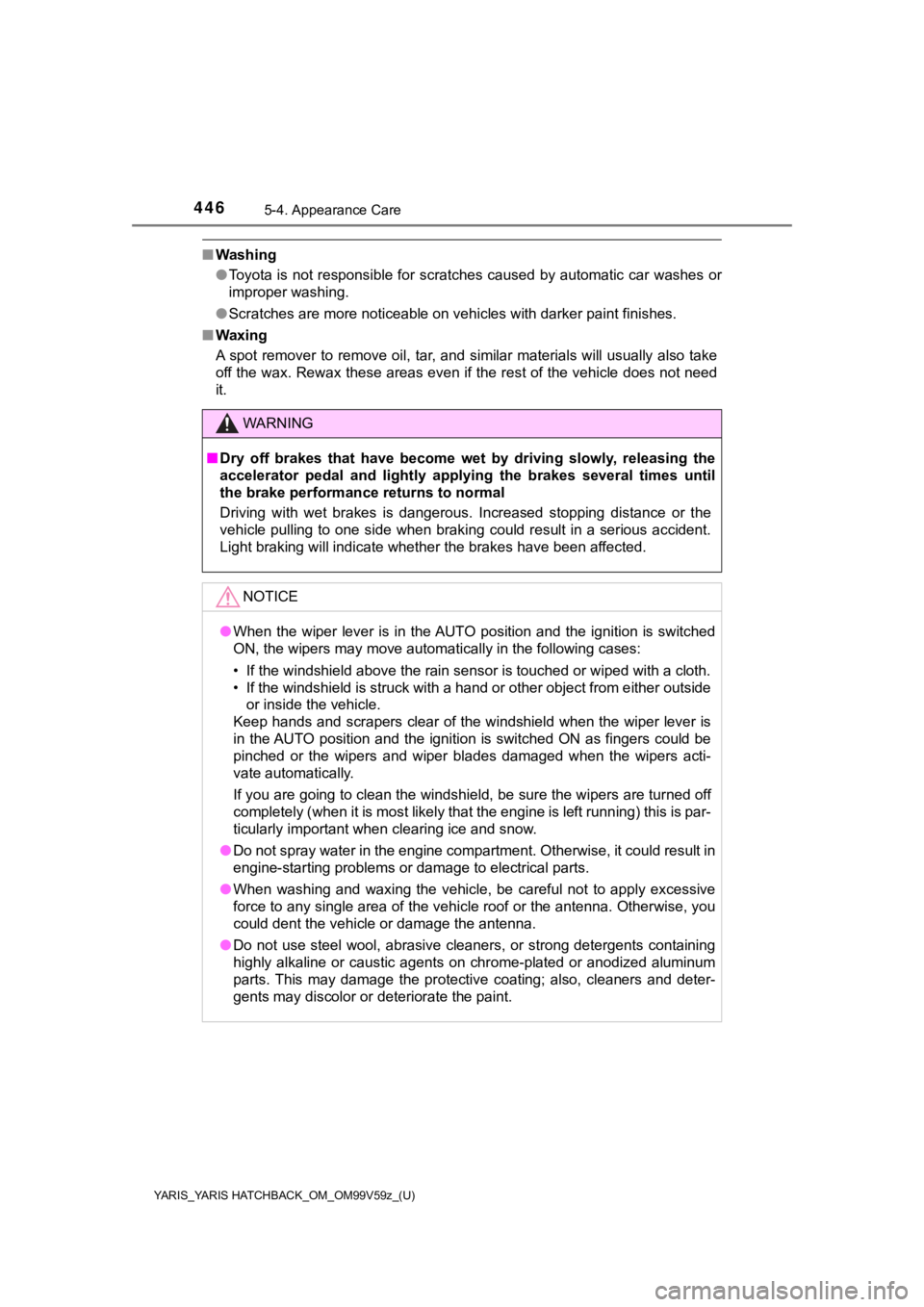
4465-4. Appearance Care
YARIS_YARIS HATCHBACK_OM_OM99V59z_(U)
■Washing
●Toyota is not responsible for scratches caused by automatic car washes or
improper washing.
● Scratches are more noticeable on vehicles with darker paint fin ishes.
■ Waxing
A spot remover to remove oil, tar, and similar materials will usually also take
off the wax. Rewax these areas even if the rest of the vehicle does not need
it.
WARNING
■Dry off brakes that have become wet by driving slowly, releasin g the
accelerator pedal and lightly applying the brakes several times until
the brake performance returns to normal
Driving with wet brakes is dangerous. Increased stopping distan ce or the
vehicle pulling to one side when braking could result in a seri ous accident.
Light braking will indicate whether the brakes have been affect ed.
NOTICE
●When the wiper lever is in the AUTO position and the ignition is switched
ON, the wipers may move automatically in the following cases:
• If the windshield above the rain sensor is touched or wiped with a cloth.
• If the windshield is struck with a hand or other object from e ither outside
or inside the vehicle.
Keep hands and scrapers clear of the windshield when the wiper lever is
in the AUTO position and the ignition is switched ON as fingers could be
pinched or the wipers and wiper blades damaged when the wipers acti-
vate automatically.
If you are going to clean the windshield, be sure the wipers ar e turned off
completely (when it is most likely that the engine is left runn ing) this is par-
ticularly important when clearing ice and snow.
● Do not spray water in the engine compartment. Otherwise, it cou ld result in
engine-starting problems or damage to electrical parts.
● When washing and waxing the vehicle, be careful not to apply ex cessive
force to any single area of the vehicle roof or the antenna. Otherwise, you
could dent the vehicle or damage the antenna.
● Do not use steel wool, abrasive cleaners, or strong detergents containing
highly alkaline or caustic agents on chrome-plated or anodized aluminum
parts. This may damage the protective coating; also, cleaners a nd deter-
gents may discolor or deteriorate the paint.
Page 498 of 572

4986-7. Warning/Indicator Lights and Warning Sounds
YARIS_YARIS HATCHBACK_OM_OM99V59z_(U)
■Low Fuel Warning Light
The light illumination timing may vary because fuel inside the fuel tank moves
around according to the driving conditions and the vehicle post ure.
■ Seat Belt Warning Light
●The warning light flashes for about 6 seconds if the driver’s s eat belt is not
fastened when the ignition is switched ON.
● To allow the front passenger occupant classification sensor to function prop-
erly, do not place and sit on an additional seat cushion on the front passen-
ger’s seat. The sensor may not function properly because the ad ditional
seat cushion could cause sensor interference.
● If a small child is seated on the front passenger’s seat, the warning light may
not operate.
■ Tire Pressure Monitoring System Warning Light
●
Perform tire pressure adjustment when the tires are cold. Tire pressure
will vary according to the tire temperature, therefore let the vehicle stand
for 1 hour or only drive it 1 mile (1.6 km) or less before adju sting the tire
pressures. When pressure is adjusted on hot tires to the cold i nflation
pressure, the TPMS warning light/beep may turn on after the tir es cool
and pressure drops below specification.
Also, an illuminated TPMS warning light, resulting from the tire air pres-
sure dropping due to cold ambient temperature will remain illum inated
even if the ambient t emperature rises. In this case, it will also be neces-
sary to adjust the tire air pressures. If the TPMS warning ligh t illuminates
due to a drop in tire air pressure, make sure to check and adju st the tire
air pressures.
●Tires lose air naturally over time and the TPMS cannot tell if the tires are
getting too soft over time or you have a flat. However, when you find one
low tire in a set of four-that is an indication of trouble; you should have
someone drive the vehicle slowly forward so you can inspect any low
tire for cuts and any metal objects sticking through tread or s idewall. Put
a few drops of water in the valve stem to see if it bubbles ind icating a
bad valve. Leaks need to be addressed by more than simply reinf lating
the tire as leaks are dangerous - take it to your Toyota dealer .